 Front page > Software tutorial > How to Protect Files/Folders against Ransomware Attacks in Windows 10
Front page > Software tutorial > How to Protect Files/Folders against Ransomware Attacks in Windows 10
How to Protect Files/Folders against Ransomware Attacks in Windows 10
Do you know how to protect yourself against Ransomware?
This online attack is a growing threat, but there are ways to stay safe.
This article illustrates several effective ways to protect your valuable file and data from malware (ransomware) attacks and threats. To protect certain important files and folders, the best form of defense might be putting the content under lock and key. And there are some quick and easy ways of protecting files and folders on Windows 10. Let's see:
- Option 1: Enable Ransomware protection
- Option 2: Backup files and folders
- Option 3: Encrypt files and folders
- Option 4: Keep your PC up-to-date
Option 1: Enable Windows Defender Ransomware Protection
Controlled folder access in Windows Defender Security Center reviews the apps that can make changes to files in protected folders. While it is disabled by default, you can enable it to monitor your apps for activities that may be malicious. Block an illegitimate app from making illegitimate changes to your files.
Step 1: Open the Windows Defender Security Center, and click the Virus & threat protection icon.

Step 2: Click on Ransomware protection link. (Or click on the Virus & threat protection settings links if you are using later versions of Windows 10.
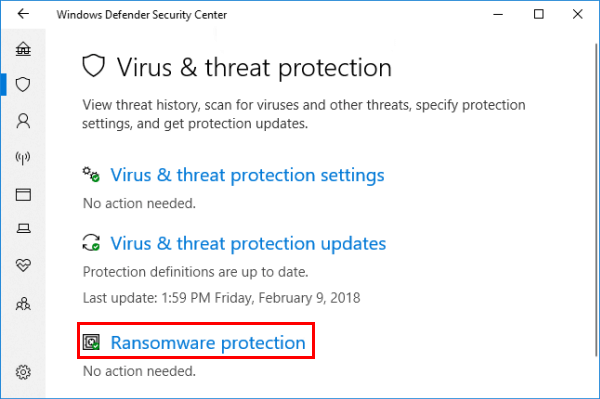
Step 3: Turn on Controlled folder access switch. And click on Protected folders link to add a protected folder you want.
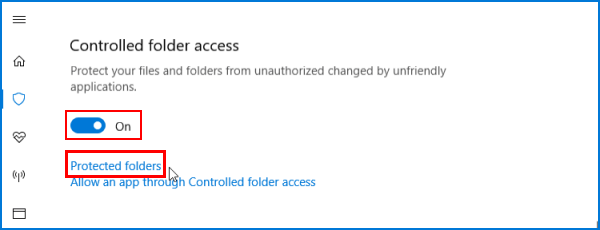
Step 4: Click on the button, and then navigate to select the folder you want to protect. Here you can also select network shares and mapped drives.
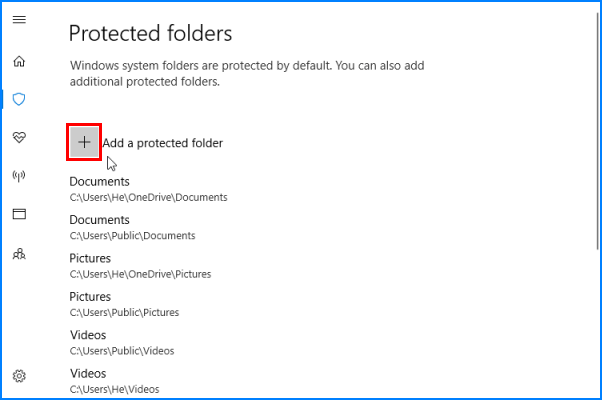
When using the Controlled Folder Access feature, you might find that some programs like Photoshop, Snagit are being blocked by Windows Defender. If you want an app or software program to access a protected folder, you can add the app to the white list. That is to say, excluding from the protection.
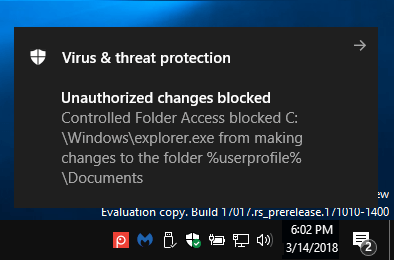
How to allow program access to your files
Step 1: Click on the Allow an app through controlled folder access link.

Step 2: Click on the Add an allowed app button to select the EXE file in the app installation folder.
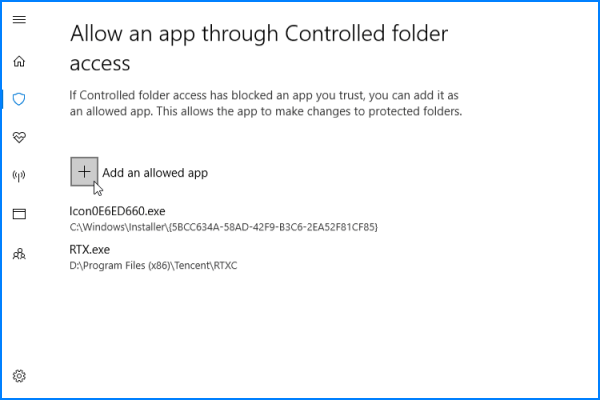
Option 2: Backup files and valuable data
You can protect yourself from ransomware by backing up your data regularly. If you back up your data frequently, there's little reason to pay a ransom after an attack. You can just wipe the hard drive and reinstall your data from the backup. Experts explain that off-site "cloud" backups may be safer than using an external hard drive, which can sometimes be zapped with the same ransomware as the computer. But a hard-drive backup is much better than no backup at all. Do remember that this feature is not an alternative to regular backups. There are some useful guides on backup files and folders, see:
How to Create a File History Backup in Windows 10
How to Back up Your Personal Data in Windows 10
When backing up files, be sure to back up your personal files to a location where they can't be written to or erased. For example, place them on a removable hard drive or upload them to a remote backup service.
Option 3: Protect data by encrypting them with Windows Built-in Software
To protect your folders from prying eyes, you can use Windows folder encryption, which offers file obfuscation that locks a file to your account. That way, if someone on another account or someone who copied your files away to another PC, tried to access your content, they'd need to know your account password. While anyone uses your PC and account would have full access. You can also create an Encrypted Archive by using compression software, like 7-Zip, Win RAR, and so forth.
For Office document, you can apply encryption and secure them with a password. To password protect a document in Office app, see: How to Encrypt and Add a Password to Files in Office 2010-2016.
Option 4: Keep your PC up-to-date
Experts have not reported finding malware in updates of the Windows operating system. Quite the opposite. Fast and frequent updates protect your computer. Older operating systems make easy targets for ransomware and other kinds of malware, too. In fact, outdated computers were key to spreading a form of ransomware called WannaCry in spring 2017.
One of the best ways to stay safe is to turn on automatic software updates for your operating system, whether you have a Windows or Apple computer.
-
 Windows 11 Black Screen After Login: Causes and SolutionsClick on Run new task. Type explorer.exe and press Enter. If successful, your desktop should reappear. 2. Update Graphics Drivers Outdated or corrupt...Software tutorial Published on 2024-11-08
Windows 11 Black Screen After Login: Causes and SolutionsClick on Run new task. Type explorer.exe and press Enter. If successful, your desktop should reappear. 2. Update Graphics Drivers Outdated or corrupt...Software tutorial Published on 2024-11-08 -
 Experiencing Overwatch 2 Error Code 0xE00101B0? Here’s GuideAre you bothered by the Overwatch 2 error code 0xE00101B0? How to fix it? You are in the right place. In this post, MiniTool offers you several soluti...Software tutorial Published on 2024-11-08
Experiencing Overwatch 2 Error Code 0xE00101B0? Here’s GuideAre you bothered by the Overwatch 2 error code 0xE00101B0? How to fix it? You are in the right place. In this post, MiniTool offers you several soluti...Software tutorial Published on 2024-11-08 -
 How to Check the Battery Health on a Samsung Phone (And What to Do About It)You probably keep a close eye on how much battery is left on your phone every day—that's what we commonly call battery "life." But for ...Software tutorial Published on 2024-11-08
How to Check the Battery Health on a Samsung Phone (And What to Do About It)You probably keep a close eye on how much battery is left on your phone every day—that's what we commonly call battery "life." But for ...Software tutorial Published on 2024-11-08 -
 Where Is My Computer or File Explorer on MacHow to Use Finder on MacBook Here’s what each location entails in the Finder sidebar window. Recents: The Recents folder houses your recent files, li...Software tutorial Published on 2024-11-08
Where Is My Computer or File Explorer on MacHow to Use Finder on MacBook Here’s what each location entails in the Finder sidebar window. Recents: The Recents folder houses your recent files, li...Software tutorial Published on 2024-11-08 -
 Download Official macOS Sequoia (4K) Wallpapers HereIt’s that time of year again—Apple has just concluded its WWDC 2024 keynote, unveiling a range of new platform announcements surrounding macOS Sequoia...Software tutorial Published on 2024-11-08
Download Official macOS Sequoia (4K) Wallpapers HereIt’s that time of year again—Apple has just concluded its WWDC 2024 keynote, unveiling a range of new platform announcements surrounding macOS Sequoia...Software tutorial Published on 2024-11-08 -
 9 Ways to Fix “Update Device Settings to Accept Media Transfers” Error on Windows 11When you connect your Android or iPhone to your Windows device, you can see most files in the Photos app. This is an excellent way to eliminate the ne...Software tutorial Published on 2024-11-08
9 Ways to Fix “Update Device Settings to Accept Media Transfers” Error on Windows 11When you connect your Android or iPhone to your Windows device, you can see most files in the Photos app. This is an excellent way to eliminate the ne...Software tutorial Published on 2024-11-08 -
 How to Fix Dead Rising Deluxe Remaster Lagging on WindowsHave you heard of this game - Dead Rising Deluxe Remaster? It was released not long ago, and some players may encounter the Dead Rising Deluxe Remaste...Software tutorial Published on 2024-11-08
How to Fix Dead Rising Deluxe Remaster Lagging on WindowsHave you heard of this game - Dead Rising Deluxe Remaster? It was released not long ago, and some players may encounter the Dead Rising Deluxe Remaste...Software tutorial Published on 2024-11-08 -
 5 Ways to Fix Google Photos App Not Showing All PhotosBasic Fixes Check your network connection – Ensure your phone is connected to a good internet connection. Check its speed online. Inspect your phone’s...Software tutorial Published on 2024-11-08
5 Ways to Fix Google Photos App Not Showing All PhotosBasic Fixes Check your network connection – Ensure your phone is connected to a good internet connection. Check its speed online. Inspect your phone’s...Software tutorial Published on 2024-11-08 -
 How to Change FaceTime Phone NumberChange FaceTime Phone Number on iPhone Your phone number and Apple ID become your FaceTime Caller ID on your iPhone. Here’s how to change your FaceTim...Software tutorial Published on 2024-11-08
How to Change FaceTime Phone NumberChange FaceTime Phone Number on iPhone Your phone number and Apple ID become your FaceTime Caller ID on your iPhone. Here’s how to change your FaceTim...Software tutorial Published on 2024-11-08 -
 Until Dawn Save File Location: How to Find & Safeguard FilesUntil Dawn was first released for PS4 in August 2015. Now, this game is available for PS5 and Windows players. Most Until Dawn players are curious abo...Software tutorial Published on 2024-11-08
Until Dawn Save File Location: How to Find & Safeguard FilesUntil Dawn was first released for PS4 in August 2015. Now, this game is available for PS5 and Windows players. Most Until Dawn players are curious abo...Software tutorial Published on 2024-11-08 -
 6 Ways to Find and Empty Trash on iPhoneWith the 64GB and 128GB models being a popular choice, it is no surprise iPhone users occasionally go into deleting mode to remove anything unimportan...Software tutorial Published on 2024-11-08
6 Ways to Find and Empty Trash on iPhoneWith the 64GB and 128GB models being a popular choice, it is no surprise iPhone users occasionally go into deleting mode to remove anything unimportan...Software tutorial Published on 2024-11-08 -
 4 Ways to Fix Display Brightness Not Working on MacFix 1: Check Display Dimming Settings Step 1: Open Settings > click on Battery from the left menu. Step 2: Scroll to the bottom on the right side > se...Software tutorial Published on 2024-11-08
4 Ways to Fix Display Brightness Not Working on MacFix 1: Check Display Dimming Settings Step 1: Open Settings > click on Battery from the left menu. Step 2: Scroll to the bottom on the right side > se...Software tutorial Published on 2024-11-08 -
 New iPads and 5 Other Announcements: What to Expect From Apple’s ‘Let Loose’ EventApple's "Let Loose" May 7 product blitz is happening unusually early at 7AM PT / 10 AM PT, with a pre-taped keynote premiering on YouTu...Software tutorial Published on 2024-11-08
New iPads and 5 Other Announcements: What to Expect From Apple’s ‘Let Loose’ EventApple's "Let Loose" May 7 product blitz is happening unusually early at 7AM PT / 10 AM PT, with a pre-taped keynote premiering on YouTu...Software tutorial Published on 2024-11-08 -
 How to View Notes in PowerPoint While Presenting With One MonitorLook for the Use Presenter View option in the “Monitors” option and click the check box to enable it. Now, under the same section, begin the slide sh...Software tutorial Published on 2024-11-08
How to View Notes in PowerPoint While Presenting With One MonitorLook for the Use Presenter View option in the “Monitors” option and click the check box to enable it. Now, under the same section, begin the slide sh...Software tutorial Published on 2024-11-08 -
 Steam Login Error Code E87 on Windows: Troubleshooting GuideSteam is a digital platform that is popular among game enthusiasts, providing a lot of video games and community features. However, sometimes you may ...Software tutorial Published on 2024-11-08
Steam Login Error Code E87 on Windows: Troubleshooting GuideSteam is a digital platform that is popular among game enthusiasts, providing a lot of video games and community features. However, sometimes you may ...Software tutorial Published on 2024-11-08
Study Chinese
- 1 How do you say "walk" in Chinese? 走路 Chinese pronunciation, 走路 Chinese learning
- 2 How do you say "take a plane" in Chinese? 坐飞机 Chinese pronunciation, 坐飞机 Chinese learning
- 3 How do you say "take a train" in Chinese? 坐火车 Chinese pronunciation, 坐火车 Chinese learning
- 4 How do you say "take a bus" in Chinese? 坐车 Chinese pronunciation, 坐车 Chinese learning
- 5 How to say drive in Chinese? 开车 Chinese pronunciation, 开车 Chinese learning
- 6 How do you say swimming in Chinese? 游泳 Chinese pronunciation, 游泳 Chinese learning
- 7 How do you say ride a bicycle in Chinese? 骑自行车 Chinese pronunciation, 骑自行车 Chinese learning
- 8 How do you say hello in Chinese? 你好Chinese pronunciation, 你好Chinese learning
- 9 How do you say thank you in Chinese? 谢谢Chinese pronunciation, 谢谢Chinese learning
- 10 How to say goodbye in Chinese? 再见Chinese pronunciation, 再见Chinese learning
























